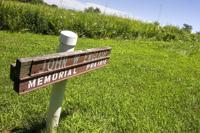NORMAL — Jessica Chambers of the ParkLands Foundation remembers the lament of a speaker who came to town for a nature talk a few years ago.
“He said, ‘I drove four hours through the ‘Prairie State’ and never saw a prairie,’” Chambers recalls.
Fortunately, with a little exploring, you can find original remnant and restored prairies to give you a sense of how Illinois earned its nickname as “the Prairie State.”
To Mary Jo Adams of rural Carlock, a master naturalist with projects at Comlara Park, prairies are anything but boring.
At one point, nearly 22 million acres — about 60% of Illinois — were covered in tallgrass prairie. Less than one-hundredth of 1% of original prairie is left. Some of that original prairie survives in pioneer cemeteries that were never plowed, such as Weston Cemetery Prairie in northeast McLean County.
The John English Prairie is on County Road 2300 North, east of the intersection with County Road 1300 East. Park on the east side of the Six Mile Creek Bridge.

“What Sherri (Snyder) and I and a couple of others are trying to do is inventory the flora of the park,” said Adams. “We try to come out here every month” to record what’s blooming.
Tall compass plants reach to the sky. The purple of prairie blazing star seems to shout, “Look at me.” The round blossoms of rattlesnake master look like something out of a book by Dr. Seuss.

Weston Cemetery Prairie is small but mighty, said Chambers. “All that life in those 2 acres.”
Close to 100 native plant species have been found there, according to the Illinois Nature Preserves Commission.
The entrance road to the prairie is a half-mile east of Weston, off U.S. 24, between Chenoa and Fairbury.
But Adams warns, “There really are no trails. Wear long pants and decent shoes.”
PHOTOS: John English Prairie Trail
81020-blm-loc-4explore

081020-blm-loc-6explore

081020-blm-loc-8explore

081020-blm-loc-12explore

